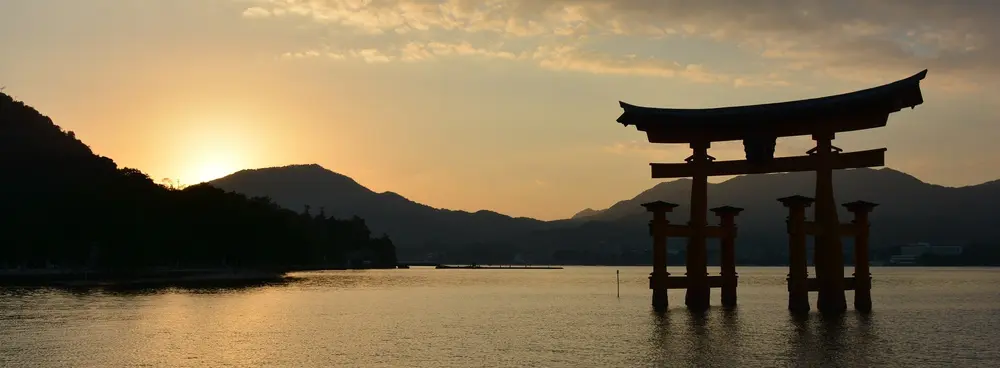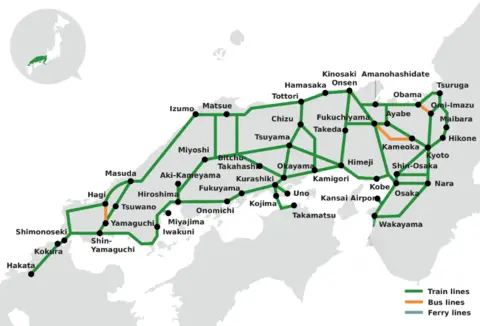Sanyo San'in Pass

La regione del West / Sanyo
Scoprite Hiroshima, restaurata dopo la seconda guerra mondiale, col suo memoriale ed il castello simbolo di quello che fu il suo sistema feudale.
La città di Fukuoka ti sorprenderà con la sua cultura originale: in effetti, il suo porto posizionato proprio di fronte alla Corea, fu il centro dei primi scambi tra l'arcipelago ed il continente. Miscuglio affascinante tra natura, urbanità e tradizione, è una città storica da non mancare.
Per finire, fermatevi ai giardini di Okayama, incantevole miscuglio di colori e luce. Il pass vi permetterà di usare tutti i trasporti tra Osaka, Nara e Kyoto e anche il traghetto per Miyajima. Qui potrete ammirare il celebre Toori del santuario di Itsukushima, sito appartenente al patrimonio mondiale dell'UNESCO.

Highlights of the SANYO-SANIN Pass:
How to use the SANYO-SANIN Pass
Delivery
- We will send the e-voucher to your email address within 5 business days of your order. If you want to get it sooner, please contact us. (The e-voucher is NOT the actual ticket, you cannot take trains using the voucher)
- You can print out the e-voucher on paper, or you can simply show the voucher on your mobile device when you exchange it.
Exchange
You can exchange the voucher for the Sanyo-Sanin Pass at one of the following locations:
(you will need to present your passport at the time of exchange)
Validity
The voucher we send you is valid for 90 days from the date of issue, and must be exchanged in Japan within this time.
The Sanyo-Sanin Pass is usable for 7 days from the date of activation.
The following train lines are included in the pass:
Seat Reservations
- With the pass, no additional fee is required for reserved seats.
- Non-reserved Ordinary Class cars can be accessed freely just by showing the pass.
- For reserved first-class seats (Green cars), you will have to pay additional fees.
- To access the platforms, show your pass to the JR staff located at the platform gates.
- To reserve a seat, take the pass to JR staff at the ticket office.
- It is a personal pass, and cannot be transferred to someone else.
- Please always carry your passport when using the pass, as station and train staff may check it.
Cancellation and Modification
- An unused voucher is refundable for up to one year from the date of issue.
- The voucher can be refunded if it has never been exchanged in Japan for the pass.
- A cancellation fee of 15% of the price of the voucher will be retained.
- No refund is possible for a voucher more than one year after the date of issue.
- No refund is possible for a lost or stolen pass.
Eligibility
Visitors traveling as tourists who have a temporary visitor entry status are eligible to use this pass.
Japanese passport holders are not eligible for this pass.
Exploring Western Japan
The Sanyo and Sanin regions of Japan encompass a wide range of prefectures and locales, taking travelers from the largest cities to the charming, though often overlooked, countryside. Access the sandy beaches of Wakayama, the bustling urbanscape of Osaka, and then keep heading down to see the historic Hiroshima, and then top off your journey with Kyushu, whose largetst city of Fukuoka is a culinary capital with countless activities to offer.
Fukuoka
La città più meridionale coperta dal pass è Fukuoka, che sorprenderà i visitatori per la sua cultura unica; la sua area portuale, situata di fronte alla Corea, è stata il centro dei primi scambi tra il Giappone e il resto del continente asiatico.
Fukuoka ha la sua parte di bellissimi santuari e templi per chi è alla ricerca di siti storici. Uno dei quartieri più famosi di Fukuoka, Hakata, è famoso in tutto il mondo per il suo cibo di strada e per il leggendario Hakata Tonkotsu Ramen, una prelibatezza locale a base di brodo di ossa di maiale cotte a fuoco lento.
Un'affascinante miscela di urbanità e tradizione, un'area storica assolutamente da visitare.
Hiroshima
Hiroshima, a una distanza relativamente breve con lo Shinkansen da Osaka e Kyoto nel Kansai, si è guadagnata un posto struggente nella storia del mondo, dove nel 1945 fu sganciata la prima bomba atomica. Ma questa città moderna non offre solo ricordi. Con il suo Peace Memorial Park, è una città di speranza. Offre ai visitatori numerose attrazioni turistiche, tra cui il castello di Hiroshima ricostruito e i giardini Shukkei-en.
Inoltre, Hiroshima è spesso citata per la sua cultura culinaria, che offre interpretazioni uniche dei cibi di strada giapponesi, come l'Okonomiyaki, che spesso ha la yakisoba sul fondo per differenziarsi dalla versione più classica di Osaka. Anche le ostriche sono una famosa prelibatezza di Hiroshima, spesso consumate crude o in altri piatti. Visitate questa città simbolo della cultura e della storia!
Area di Chugoku
Il pass comprende anche luoghi come il Santuario di Izumi a Shimane, Tottori e le sue famose dune di sabbia, Tsuruga a Fukui, nota per le sue grandi spiagge, nonché le stazioni di Takamatsu sull'isola di Shikoku e Uno, entrambi punti di accesso all'isola d'arte di Naoshima. Quest'area è facilmente raggiungibile in treno da Hiroshima.
Area di Kansai
Non perdetevi i giardini Korakuen a Okayama, uno dei tre migliori giardini del Giappone. Il pass consente anche di utilizzare i trasporti tra Osaka, Nara e Kyoto e il traghetto per Miyajima a Hiroshima, dove si può ammirare il famoso Torii del Santuario di Itsukushima, patrimonio mondiale dell'UNESCO.
Il JR Sanyo Sanin Area Pass consente l'accesso a una serie di destinazioni molto diverse, raggiungibili attraverso una serie di sistemi ferroviari, tra cui il Sanyo Shinkansen, servito da treni come il Nozomi Shinkansen, il Mizuho Shinkansen, l'Hikari Shinkansen, il Sakura Shinkansen e il Kodama Shinkansen.
Domande frequenti









